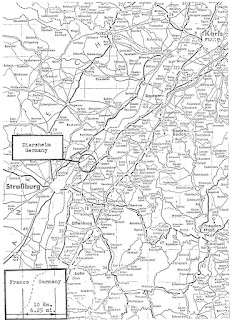I probably didn't fully realize how important genealogy is to understanding who I am as a human being until 2004. I went to Diersheim, Germany, to meet my mom's 6th cousin. She was 79 years old then. Twelve years later (yes, she's 91 now!) we still email and she tells me that she still rides a bicycle every day!
A SIXTH cousin! She and I started writing letters back in the 70s long before computers were around. We shared much of our family research over the years. She translated family letters from German to English and explained to me that previous translations were incorrect because they didn't take into consideration local word meaning. That was an interesting lesson - you can't just have a letter translated, you need to find someone who knows the local dialect.
Diersheim is on the Rhine River and used to be an island where the river split. Sometimes France owned the village, other times Germany owned it. Until finally, Germany blocked off the river and made it part of their country.
In 1817, my ancestors left and took the journey across the Atlantic. Her ancestors stayed. This cousin is a retired history teacher who studies genealogy and speaks and writes English - one of 2 or 3 people in the village who know English. Her nephew, one of the only car owners in the village of 700 people, took the day off work and the 2 of them took us to all the local "family" spots. It is too expensive to own a car so everyone just rides a bicycle.
We saw where our ancestors stepped foot on the small boat that took them up the Rhine River to Amsterdam where they boarded a ship. I wouldn't exactly call it a "river", but she did! The area around Diersheim looks so much like the area in Indiana where this family settled. It must have made them feel at home and comfortable in their surroundings. I would never have made that connection had I not traveled to Germany to see where they came from.
We saw their house - they had enough money that they did not need to sell if before they left. These are known as "half-timber houses" and I have read that the placement of the timbers could identify that a Jewish family lived there. I saw a book at the Strasbourg Jewish museum that showed such placements.
We went into their church and climbed into the belfry to see where they helped install a bell. That bell, the alter, the pews, everything inside the church looked much like many rural Indiana churches.
We participated in a "wedding supper" where the traditions have not changed in the 200+ years since our ancestors parted ways. I actually see resemblances in these distant cousins to my close cousins, aunts and uncles....
We toured the only cemetery which has been there since before 1515 and I learned that each family has a plot. Every 25 years they merely bury on top of the last person. So no headstones to view...just a family name.
Perhaps the greatest experience was the family dinner. Meat and potatoes. Cooked exactly like my grandmother fixed them. Exactly. With fresh cooked green beans. I will never forget this meal because I thought I was sitting at my Grandmother's table once again.
How could this meal, this tradition of cooking, remain the same for over 200 years? The seasonings used were identical. The cooking style - identical. I think I "woke up" at that moment and truly started looking for other "traditions" that were the same. It was an amazing experience.
This tiny village has remained intact and much unchanged since the Lutherans invaded Germany about 1515. These Lutherans decided that you had a couple of options. You could convert to Lutheranism, leave, or be killed. They destroyed every record at the tiny church prior to 1520. Absolutely nothing remains. 100% of the residents are Lutheran. The population has never grown - always remaining between 700 and 1000 residents (mostly due to the geographical limitations.) Strasbourg, just across the Rhine River, once had a huge Jewish population. Surely, when this village was owned by France, there were Jews living there. Yet if you were seeking Jewish ancestry, all of that information would have been destroyed about 1515. Good to know.
My suggestion is that you do enough of your family tree to find a distant cousin who still lives in a quaint, unpopulated village in a remote part of the country your ancestors came from. Go visit. You will learn where your traditions came from. All of us would like to think that we are very "modern", but my trip to Germany taught me just how tied to traditions my family is!
If your ancestors lived in Cotopaxi, come on down! We'll be happy to show you all the "family" spots and perhaps it will give you a better understanding of where your traditions came from. Sorry, I won't be fixing you "meat and potatoes"! However, I can almost guarantee you that you will walk away with a new understanding of what their life was like in 1882 when they tried hard to farm the Rocky Mountains in a time when Indians, cow rustlers, and hunting gold was a way of life!
I do believe that genealogy is the "meat and potatoes" of who we are. The more you know about the past, the more you know about yourself and who you really are.








No comments:
Post a Comment